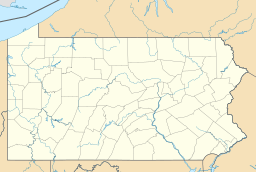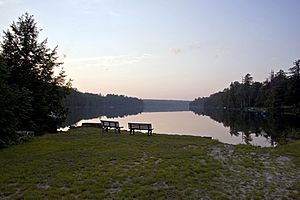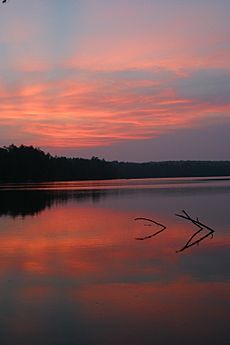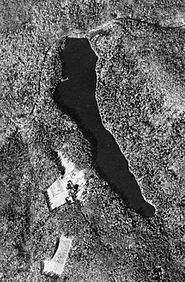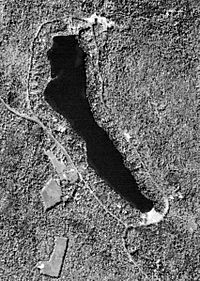Ganoga Lake facts for kids
Quick facts for kids Ganoga Lake |
|
|---|---|
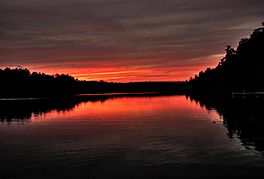
Sunset on Ganoga Lake
|
|
| Location | Colley, Sullivan, Pennsylvania |
| Coordinates | 41°21′22″N 76°19′06″W / 41.35611°N 76.31833°W |
| Type | Lake |
| River sources | Kitchen Creek |
| Max. length | 0.88 miles (1.42 km) |
| Surface area | 78.8 acres (31.9 ha) |
| Average depth | 13 feet (4.0 m) |
| Surface elevation | 2,260 feet (690 m) |
Ganoga Lake is a natural lake located in Colley Township, southeastern Sullivan County, Pennsylvania, United States. For much of the 1800s, it was known as Robinson's Lake and Long Pond.
The Ricketts family bought the lake in the early 1850s. After the American Civil War, R. Bruce Ricketts owned a lot of land in the area, including the lake. Because it's one of the highest lakes in Pennsylvania, Ricketts first called it Highland Lake in 1874. Then, in 1881, he renamed it Ganoga Lake. The name Ganoga was suggested by Pennsylvania senator Charles R. Buckalew. It comes from the Seneca language and means "water on the mountain".
The Ricketts family built a stone house by the lake around 1852. This house was used as a hunting lodge and a place for travelers to stay. In 1873, a large wooden part was added, turning it into a hotel called the North Mountain House. This hotel even had one of the first summer schools in the U.S. in 1876 and 1877. A special train line went to the lake, serving the hotel and carrying ice cut from the lake for cooling. The hotel closed in 1903, but the house remained the Ricketts family's summer home.
After R. Bruce Ricketts passed away in 1918, his family sold much of his land to the state. This land became parts of Pennsylvania State Game Lands and Ricketts Glen State Park. In 1957, the state tried to buy the lake, but a group of investors bought it instead. They turned the land around the lake into a private neighborhood. Because of this, Ganoga Lake is now "off limits" to the general public.
Ganoga Lake sits on the Allegheny Plateau, just north of the Allegheny Front. Its rocks are from the Pocono Formation. About 20,000 years ago, the Wisconsin Glaciation (a period of glaciers) changed how water flowed from the lake. This sent its water into Kitchen Creek. As the water flowed, it helped create the 24 famous waterfalls in Ricketts Glen State Park. Ganoga Lake has a continental climate, meaning it has warm summers and cold winters. The area around the lake is mostly forest and is an Important Bird Area. Many different plants and animals live here, but the environment has been affected by acid rain.
Contents
About Ganoga Lake
Ganoga Lake is a natural spring-fed lake. It is located west of Pennsylvania Route 487 in southern Colley Township. The lake is close to where Sullivan, Columbia, and Luzerne counties meet. It is also less than 0.4 miles (0.6 km) northwest of Ricketts Glen State Park.
The lake is on the Allegheny Plateau at an elevation of 2,260 feet (690 m). William Reynolds Ricketts, who owned the lake in the early 1900s, said it was the highest lake east of the Rocky Mountains. The United States Geological Survey says it's the second highest in Pennsylvania. However, the Pennsylvania Audubon Society calls Ganoga Lake "the highest elevation natural lake in Pennsylvania".
Ganoga Lake has a long, narrow oval shape. It stretches from north-northwest to south-southeast. In 1936, William Reynolds Ricketts described the lake as about 0.88 miles (1.42 km) long. He said it was typically 700 to 800 feet (210 to 240 m) wide. However, a 1917 report stated it was 3,720 feet (1,130 m) long (about 0.705 miles (1.135 km)) and 1,025 feet (312 m) wide. The lake is about 10 feet (3.0 m) deep on average. Its deepest point is 13 feet (4.0 m). The area that drains into the lake is 1.5 square miles (3.9 km2). The lake can hold about 373 acre-feet (460,000 m3) of water.
A part of Kitchen Creek flows out from the southern end of the lake. About 0.4 miles (0.64 km) downstream, this water enters Lake Jean. Lake Jean is located in Ricketts Glen State Park. From Lake Jean, the water flows through Ganoga Glen. There are 10 named waterfalls in this glen. Then, it joins the main part of Kitchen Creek. Below this point, the creek flows over five more named waterfalls. Kitchen Creek eventually flows into Huntington Creek. Huntington Creek then joins Fishing Creek. Finally, Fishing Creek flows into the Susquehanna River.
History of Ganoga Lake
Early Inhabitants and Names
The land around Ganoga Lake is part of the Susquehanna River area. The first known people to live here were the Iroquoian-speaking Susquehannocks. Their numbers decreased due to sickness and wars. By 1675, they had either left or joined other tribes. After this, the Iroquois tribe controlled the Susquehanna valley. They allowed other tribes, like the Shawnee and Lenape, to settle there.

On November 5, 1768, the British bought this land from the Iroquois. This purchase was part of the Treaty of Fort Stanwix. After the American Revolutionary War (1775–1783), most Native Americans left Pennsylvania. The lake was first in Northumberland County. Then it became part of Lycoming County in 1795. Sullivan County was created from Lycoming County in 1847. Two years later, Colley Township was formed. A Native American pot was found near Kitchen Creek around 1890. It was decorated in the style of the people from the Susquehanna region.
Around 1800, a hunter named Robinson lived in a cabin at the north end of the lake. He gave the lake its first known name: Robinson's Lake. However, for most of the 1800s, people called it Long Pond because of its long shape. From 1822 to 1827, a turnpike was built along the lake's western shore. This road connected Berwick in the south to Towanda in the north. Starting in 1827, a daily stagecoach would stop at the Long Pond Tavern for lunch. The stagecoach ran until 1851. Today, Pennsylvania Route 487 follows parts of this old road.
In 1850, brothers Elijah and Clemuel Ricketts were on a hunting trip. They decided to buy land for their own hunting area. In 1851 or 1853, they bought 5,000 acres (2,000 ha), including the lake. They built a stone house on the lake shore by 1852 or 1855. This house was their lodge and a tavern. People called it "Ricketts Folly" because it was so far out in the wilderness. Clemuel passed away in 1858, and Elijah bought his share of the land and house.
R. B. Ricketts and the North Mountain House
Elijah's son, Robert Bruce Ricketts, joined the Union Army in 1861. He became a colonel during the American Civil War. After the war, R. B. Ricketts returned to Pennsylvania. On September 25, 1869, he bought the stone house, the lake, and some land from his father. He paid $3,969.81 for it. Eventually, he owned or controlled over 80,000 acres (32,000 ha). This included the lake and the glens with their waterfalls.
From 1872 to 1875, Ricketts and his partners ran a sawmill near the lake. In 1872, Ricketts used wood from the mill to build a three-story addition next to the stone house. This became the North Mountain House hotel, which opened in 1873. Ricketts' brother, Frank, managed the hotel until 1898. Many of Ricketts' friends and family stayed at the hotel. Guests also came from cities like Wilkes-Barre, Philadelphia, and New York City. Many guests stayed all summer, from June to September. In 1876 and 1877, Ricketts held one of the first summer schools in the United States at his house and hotel. Joseph Rothrock, who later became known as the "Father of Forestry" in Pennsylvania, was one of the teachers.
Ricketts and others in the area didn't know about the waterfalls in what is now the state park until about 1865. Two of the Ricketts' guests found them while fishing. In 1879, Ricketts started the North Mountain Fishing Club. Guests of the hotel could pay one dollar to fish as club members. By 1874, Ricketts had renamed Long Pond to Highland Lake. By 1875, he named the highest waterfall on Kitchen Creek as Ganoga Falls. In 1881, Ricketts renamed Highland Lake to Ganoga Lake. Pennsylvania senator Charles R. Buckalew suggested the name Ganoga. He said it was an Iroquoian word meaning "water on the mountain". Another source says it's a Cayuga language word meaning "place of floating oil". Ganoga Lake is where the branch of Kitchen Creek that flows through Ganoga Glen begins. This glen has the tallest waterfall.
Ricketts was a lumberman who became wealthy by cutting down almost all the trees on his land. However, he did not allow logging within 0.5-mile (0.8 km) of the lake. The glens and their waterfalls in the state park were also saved from logging because of the Ricketts family's planning. In 1893, a hemlock tree cut near the lake was 6 feet (1.8 m) wide and 532 years old.
Ricketts and his business partners built the lumber town of Ricketts. It was about 4 miles (6 km) northeast of the lake and started in 1890. The town had up to 800 people and several sawmills. It operated until 1913, when all the timber was gone. A 3.85-mile (6.20 km) train line from the Lehigh Valley Railroad ran from Ricketts to the north end of the lake. It opened in 1893. This line offered daily passenger service to Wilkes-Barre and Towanda. It also carried freight trains hauling ice from the lake for cooling, starting in 1895. The ice cutting business on the lake employed 175 men. They had an 80-by-400-foot (24 by 122 m) ice house near the small log train station. The Ganoga Lake Ice Company started in 1897 and operated until about 1915. Ricketts' son, William Reynolds Ricketts, was one of the partners in the ice company. Ice skating was also a popular activity on the lake. In 1913, the lake had a boathouse and was used by rowboats.
A forest fire in 1900 threatened the North Mountain House. The loss of many nearby old trees led to fewer hotel guests. In 1903, another large fire on North Mountain threatened the sawmill in Ricketts village. The wooden addition to the stone house was taken down in either 1897 or 1903. This land then became a garden. The hotel closed in November 1903. The fishing club and passenger train service also ended.
The stone house remained the Ricketts family's summer home. After the hotel closed, small cabins were built around the lake for rent to sportsmen. Ricketts wanted to move the highway from his front yard in 1904. The Pennsylvania General Assembly approved this in 1908, after he paid for the new highway. The house was updated and added to in 1913. Ricketts passed away there during the 1918 flu pandemic. His wife died soon after, and they are buried in the Ricketts family cemetery near the north end of the lake.
Modern Era and Private Development
R. B. Ricketts and his wife had three children. Their son, William Reynolds Ricketts, lived in the house after his parents died. Between 1920 and 1924, the Pennsylvania Game Commission bought 48,000 acres (19,000 ha) from the Ricketts family. This land became most of Pennsylvania State Game Lands Number 13. These sales left the Ricketts family with over 12,000 acres (4,900 ha) around Ganoga Lake and the glens. The stone house was listed on the Historic American Buildings Survey in 1936. The area was considered for a national park in the 1930s. The National Park Service even ran a Civilian Conservation Corps camp there. However, money problems and World War II stopped these national park plans.
In 1942, the state of Pennsylvania bought 1,261 acres (510 ha). This included the glens and their waterfalls, for $82,000. Ricketts Glen State Park opened in 1944. The state bought a total of 16,000 acres (6,500 ha) more from the family in 1945 and 1950. Today, the park has about 10,000 acres (4,000 ha) from the Ricketts family. After World War II, William Reynolds Ricketts also sold the old trees around Ganoga Lake. He did this to help pay property taxes.
William Reynolds Ricketts died in 1956. The lake and surrounding land were sold in October 1957 for $109,000. The state tried to buy the 3,140 acres (1,270 ha) area, including the lake. But a group of private investors outbid them. They first planned to sell up to 788 building lots around the lake. When sales were slow, they formed the Lake Ganoga Association in September 1959. This group manages and protects the recreation and homes at Lake Ganoga. So, houses around the lake only started to be built in the 1900s.
The association built 2.5 miles (4.0 km) of roads around the lake. The Air Force paved some of these roads. This was to make it easier to reach a radio transmitter southwest of the lake. The Ganoga Lake Association also cleared some land at the lake's southern end. Its members built more than 50 houses on the lake shore. The stone house is now the association's headquarters and clubhouse. It is used for meetings, weddings, and picnics. In 1983, the house was listed on the National Register of Historic Places as the Clemuel Ricketts Mansion. Today, people use the lake for kayaking and windsurfing. Since it's a private area, "To all outsiders that have no property around the lake, the lake and grounds are off limits."
Geology and Climate of Ganoga Lake
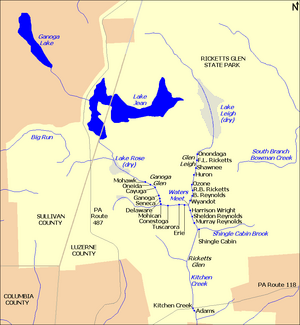
The rocks under Ganoga Lake are from the Mississippian Pocono Formation. These rocks are light gray to buff or light olive-gray. They are made of medium-grained, crossbedded sandstone, with some siltstone and conglomerates. The Pocono Formation formed over 340 million years ago. At that time, the land was a coastline of a shallow sea. This sea covered a large part of what is now North America. High mountains to the east slowly wore away. This caused a buildup of sediment like clay, sand, and gravel. Great pressure on the sediment formed the rocks found at the lake and in the drainage basin for Kitchen Creek. In 1894, R. Bruce Ricketts planned to mine yellow ocher near the lake.
Ganoga Lake is on the Allegheny Plateau. It is just north of the Allegheny Front. This front is the border between the hilly plateau to the north and the Ridge-and-Valley Appalachians to the south. Kitchen Creek, which drains the lake, drops about 1,000 feet (300 m) in 2.25 miles (3.62 km). It flows down the steep escarpment of the Allegheny Front. About 300 to 250 million years ago, the Allegheny Plateau, Allegheny Front, and Appalachian Mountains all formed. This happened when the land that became Africa crashed into what became North America. This collision formed Pangaea. Since then, up to 5,000 feet (1,500 m) of rock has been worn away by streams and weather. At least three major ice ages in the last million years have shaped the land around the lake.
Before the last ice age, Ganoga Lake flowed into Big Run. This run was a branch of Fishing Creek. This changed when the glaciers moved northeast about 20,000 years ago. They formed glacial lakes. The melting glaciers also left piles of debris 20 to 30 feet (6.1 to 9.1 m) thick. This debris formed a dam that stopped water from flowing into Big Run. Instead, water from Ganoga Lake and the area that became Lake Jean was sent into the Ganoga Glen branch of Kitchen Creek. These changes added about 7 square miles (18 km²) to the Kitchen Creek drainage basin. This increased its size by over 50 percent to 20.1 square miles (52 km2). The result was more water flowing in Kitchen Creek, which has been carving the waterfalls ever since. Scratches from glaciers are found on the eastern side of the lake. The lake is in a shallow valley, 13 feet (4.0 m) deep. It is held back by glacial till up to 30 feet (9.1 m) thick at the southeast end, where Kitchen Creek leaves.
The Allegheny Plateau has a continental climate. This means it has very cold winters and warm summers. The difference between the daily high and low temperatures is about 20 °F (11 °C) in winter and 26 °F (14 °C) in summer. Ganoga Lake is part of the Huntington Creek watershed. The average yearly rainfall is 40 to 48 inches (1,016 to 1,219 mm). Weather records for Ganoga Lake are not available. However, records for the nearby Ricketts Glen State Park are known. The highest temperature recorded at the park was 103 °F (39 °C) in 1988. The lowest was −17 °F (−27 °C) in 1984. January is usually the coldest month. July is the hottest, and June is the wettest.
| Climate data for Ricketts Glen State Park (next to Ganoga Lake) | |||||||||||||
|---|---|---|---|---|---|---|---|---|---|---|---|---|---|
| Month | Jan | Feb | Mar | Apr | May | Jun | Jul | Aug | Sep | Oct | Nov | Dec | Year |
| Mean daily maximum °F (°C) | 33 (1) |
36 (2) |
46 (8) |
59 (15) |
70 (21) |
78 (26) |
82 (28) |
80 (27) |
73 (23) |
62 (17) |
49 (9) |
37 (3) |
59 (15) |
| Mean daily minimum °F (°C) | 15 (−9) |
17 (−8) |
25 (−4) |
35 (2) |
44 (7) |
53 (12) |
58 (14) |
56 (13) |
49 (9) |
38 (3) |
30 (−1) |
21 (−6) |
37 (3) |
| Average precipitation inches (mm) | 2.76 (70) |
2.52 (64) |
3.13 (80) |
3.45 (88) |
3.80 (97) |
4.99 (127) |
4.07 (103) |
3.30 (84) |
4.49 (114) |
3.21 (82) |
3.38 (86) |
3.01 (76) |
42.11 (1,071) |
| Source: The Weather Channel | |||||||||||||
Animals and Plants of Ganoga Lake
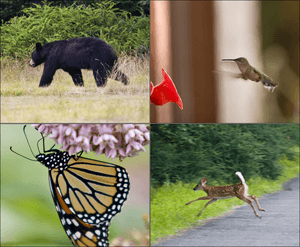
Ganoga Lake is the largest source of water for Lake Jean. It connects to Lake Jean through a 0.4-mile (0.6 km) branch of Kitchen Creek. Lake Jean is entirely within Ricketts Glen State Park. However, almost half of its 1,998-acre (809 ha) drainage area comes from Ganoga Lake's 960-acre (390 ha) watershed. The Lake Jean watershed is mostly hardwood forest (81.0%). It also has pastures (12.6%), other lakes (4.7%, including Ganoga Lake), and wetlands (1.7%). The park has over 80 types of vines, shrubs, and trees. Some common trees in the area are black gum, black spruce, eastern hemlock, eastern white pine, eastern larch, red maple, and yellow birch.
In the 1800s, Ganoga Lake was home to fish like trout, bullhead catfish, pike, pickerel, and black bass. The lake had few plants in it. But its shore was covered with mountain laurel and mountain ash. After the Ganoga Lake Association bought the lake in 1957, they drained it to remove the fish. Then, they stocked it with "30,000 fingerling brook trout". In 2007, Lake Jean, which is connected to Ganoga Lake, still had many of the same fish. These included brook trout, brown trout, brown bullhead, yellow bullhead, chain pickerel, and largemouth bass.
Even though there are no direct pollution sources, acid rain is a big worry. Acidification has changed the environment of the lakes. In Lake Jean, low pH levels have reduced the number and quality of insects and plankton. These tiny creatures are at the bottom of the food chain. Fish that can handle acid are more common. These include fathead minnow, muskellunge, pumpkinseed, walleye, and yellow perch. There are fewer predators like chain pickerel and largemouth bass. Adult fish seem to grow well, but they have trouble reproducing.
Despite the increased acidity, all of the Kitchen Creek drainage area, including Ganoga Lake, is called a "High Quality-Cold Water Fishery" by Pennsylvania. A plan called a Total Maximum Daily Load (TMDL) has been set for acid pollution in the Lake Jean watershed. Ganoga Lake's TMDL for acidity is 4.1 pounds (1.9 kg) per day. Long-term exposure to acid rain also harms the soil. It lowers calcium levels, which can affect insect populations and bird reproduction. Lake Jean is also affected by mercury from the air.
Ganoga Lake and Ricketts Glen State Park are part of a much larger 114,978-acre (46,530 ha) Pennsylvania Important Bird Area (IBA) #48. The Audubon Society says this is "the largest existing forest in northeastern Pennsylvania". Over 75 types of birds are known to breed in the state park next to the lake. Lake Jean is home to bald eagles and Canada geese. Water birds found in this area include American bittern, American black duck, great blue heron, green-winged teal, hooded merganser, mallard duck, osprey, Virginia rail, and wood duck. In the past, common pheasants were found in the woods around the lake.
Ganoga Lake is on the Allegheny Plateau, just north of the Allegheny Front. This area is known as North Mountain. Many bird species live in the forests on North Mountain. This includes Pennsylvania's only group of blackpoll warblers. Other birds seen there are evening grosbeak, northern goshawk, red crossbill, and Swainson's thrush. Historically, olive-sided flycatchers lived on North Mountain. It was also one of the few places to hear all of Pennsylvania's native thrushes sing. Today, it has the state's largest yellow-bellied flycatcher population.
Ganoga Lake and its surroundings have many insects and animals. Butterflies in the region are studied by lepidopterists. The hemlock woolly adelgid is a pest that threatens many hemlock trees. Animals found on North Mountain and in the park include squirrels, black bears, fishers, hoary bats, otters, porcupines, raccoons, and white-tailed deer. In 1912, white-tailed deer disappeared from the area. This was due to losing their homes from logging and too much hunting. Pennsylvania brought in almost 1,200 white-tailed deer from Michigan between 1906 and 1925 to bring the species back. In 1959, it became the official state animal. By 2001, there were so many deer that people worried they were eating too much of the plants.


